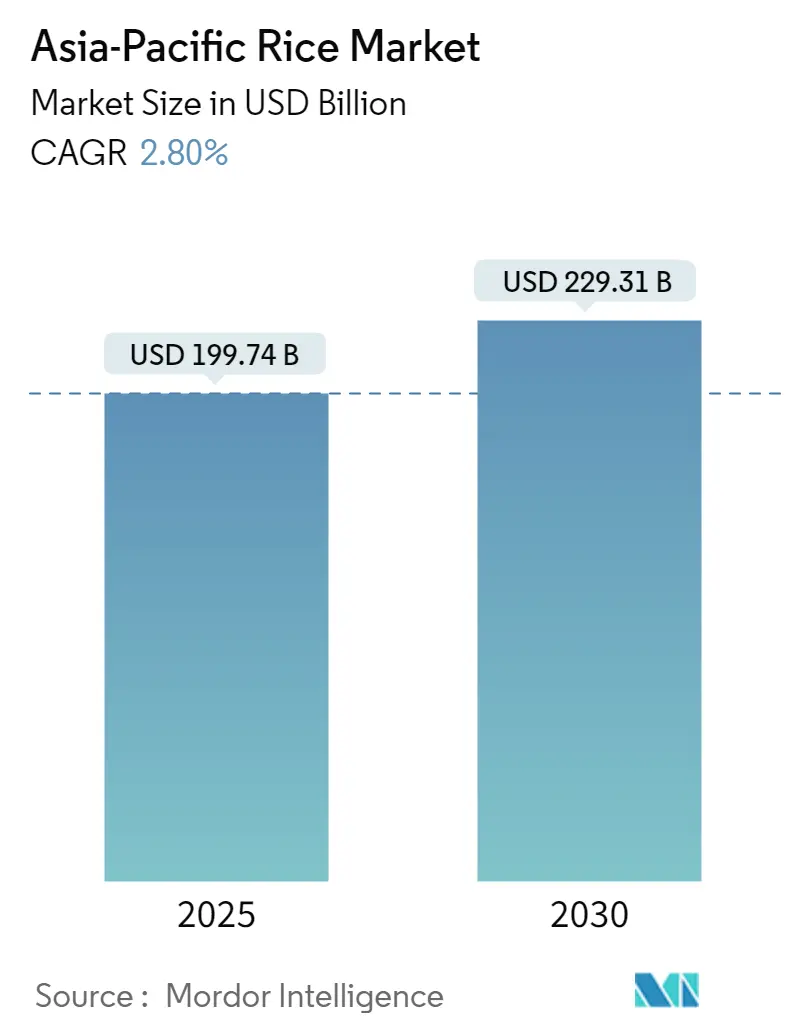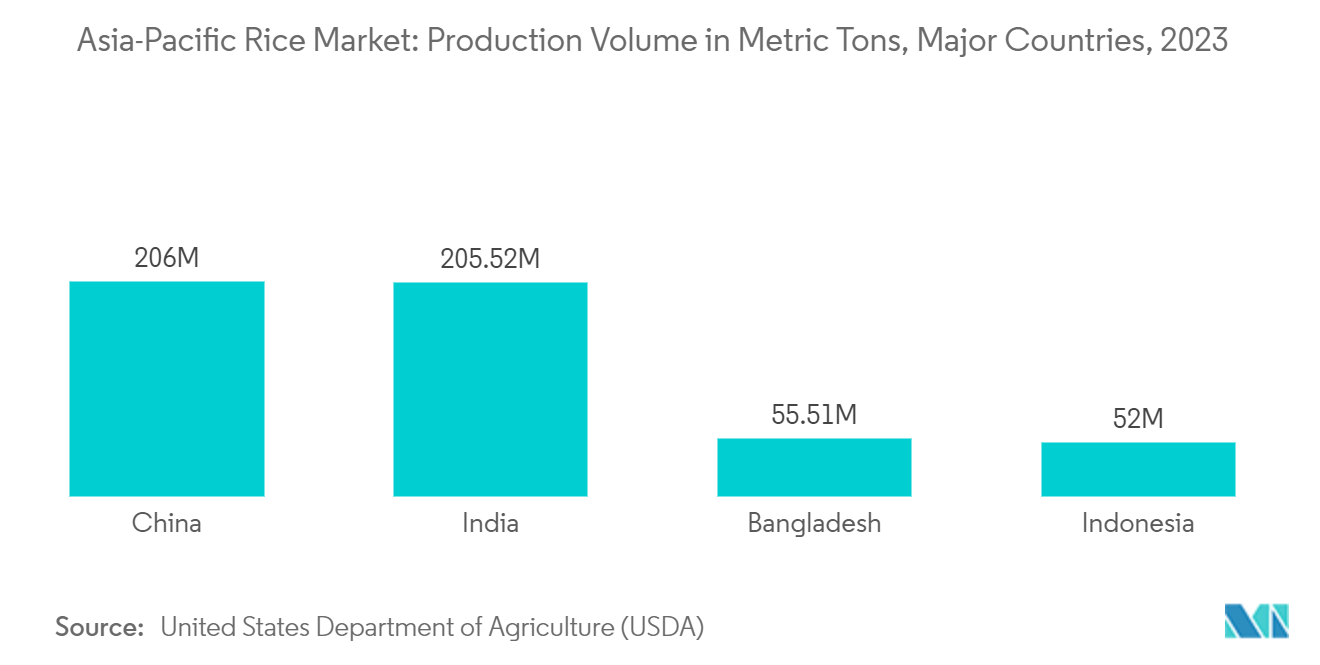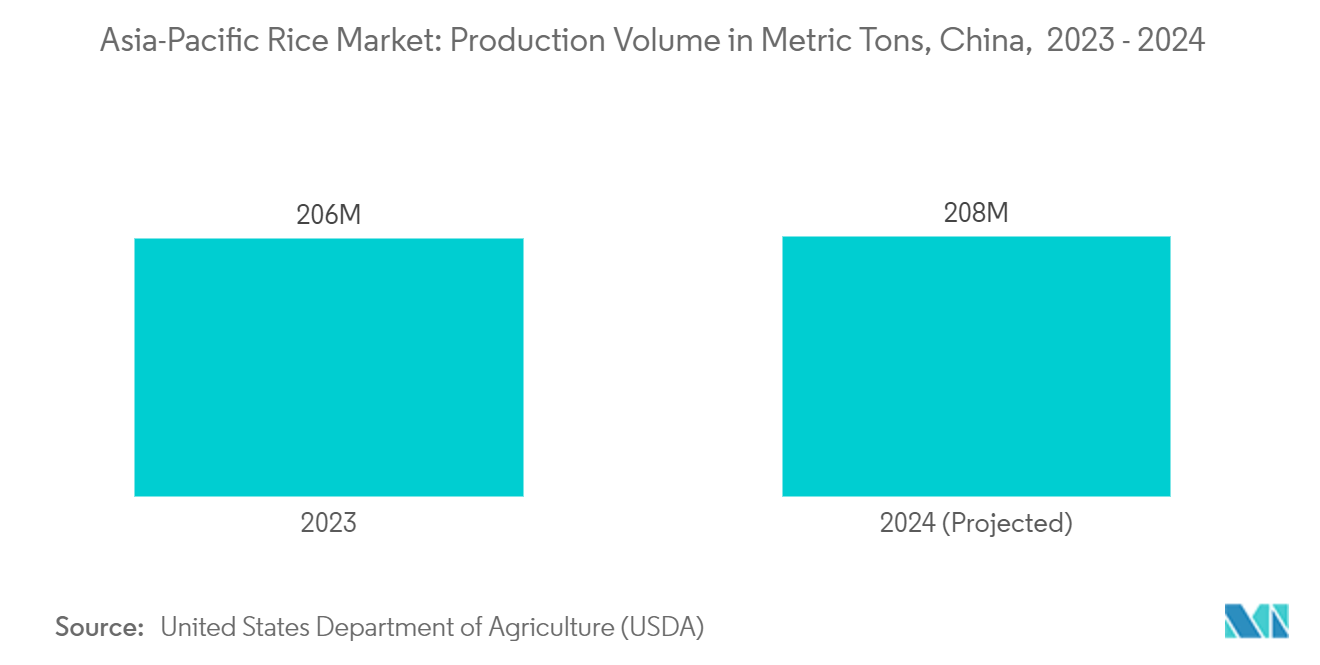
Asia Pacific Rice Market Analysis
The Asia-Pacific Rice Market size is estimated at USD 199.74 billion in 2025, and is expected to reach USD 229.31 billion by 2030, at a CAGR of 2.8% during the forecast period (2025-2030).
- Rice is a staple for 60% of Asia's population, with the continent responsible for about 90% of the world's rice cultivation and consumption. In Asia-Pacific, rice farming covers over 135 million hectares and employs more than 300 million people. Data from the United States Department of Agriculture (USDA) highlights China and India as the top global rice producers, accounting for over 50% of the world's output. Other notable contributors include Indonesia, Bangladesh, Vietnam, and Thailand.
- Under 7% of the world's rice harvest enters international trade. Thailand, Vietnam, the United States, India, and Pakistan are major exporters in this arena. These nations primarily deal in significantly larger volumes of lower-premium rice. Such varieties predominantly reach tropical developing countries, notably in Sub-Saharan Africa and the Middle East. In contrast, wealthier nations focus on importing high-value aromatic rice, with esteemed varieties like Basmati and Thai leading the demand.
- Rice production in the region grapples with challenges such as water shortages and the impacts of climate change. Elevating rice production in Asia is vital for ensuring food security, meeting the needs of a growing population, and improving farmers' livelihoods. Acknowledging these hurdles, international agricultural agencies are ramping up efforts to bolster regional rice production, focusing on boosting productivity and conserving water. In 2023, the International Atomic Energy Agency (IAEA) and Food and Agriculture Organization (FAO) launched the Atoms4Food initiative, harnessing cutting-edge nuclear techniques to elevate agricultural productivity, guarantee food safety, curtail wastage, enhance nutrition, and address climate change issues. This approach aims to amplify agricultural efficiency while safeguarding soil health. Farmers across multiple Asia-Pacific nations have embraced these technologies, achieving sustainable boosts in both productivity and profitability, thereby broadening the region's rice market.
Asia Pacific Rice Market Trends
Rising Regional Population Drives Demand
- Asia, home to roughly 4.75 billion people, represents about 60% of the global population. In 2022, the combined population of China and India exceeded 2.8 billion. The United Nations projects that Asia's population will reach 5.28 billion by 2055, which is expected to increase the demand for rice. According to the Sustainable Rice Platform (SRP) Survey, rice is central to Asian diets. Consumers in India, Indonesia, Thailand, and Vietnam indulge in rice more than five times weekly. In Pakistan, rice is a popular staple, but its consumption is more moderate, with most people eating it two to three times a week.
- The average person in the region consumes over 77 kg of food annually. In several Asian nations, rice accounts for over 70% of the calorie intake. Additionally, in Asia-Pacific, rice is the primary staple for the poorest and malnourished populations, who often lack access to or cannot afford more nutritious alternatives. Rice has become an essential commodity for the region and the world. Its significance extends beyond global food security, intertwining with economic growth, employment, and social stability.
- The International Rice Research Institute (IRRI) leads efforts to meet the food needs of Asia-Pacific. For example, IRRI is at the forefront of developing rice varieties enriched with vital nutrients, including vitamin A, zinc, and iron. Additionally, the institute is researching low glycemic index rice, which could benefit people with diabetes and those at risk. With the growing demand for rice, IRRI champions high-yielding varieties. The institute is enhancing technologies like drying and storage to combat post-harvest losses. Also, IRRI promotes mechanization, supports land consolidation, and implements near real-time information systems to address the region's rice demand.

China Leads in Both Production and Consumption
- Rice is a cornerstone food crop in China, serving as the staple for approximately 65% of its population. In 2023, China's rice cultivation and production constituted 28% of the global total of 206 million metric tons (USDA). China's climate is ideally suited for paddy cultivation, leading to widespread production, predominantly for local consumption. Rice farms, primarily in Central China, specifically in Jiangsu, Anhui, Hubei, and Sichuan along the Yangtze River Valley, contribute to approximately 49% of the nation's total rice output (National Bureau of Statistics of China).
- China's vigorous research initiatives significantly enhance its production capabilities. For instance, in 2023, trial farms in China marked a milestone by completing the second harvest of genetically modified (GM) giant rice. Developed by the Institute of Subtropical Agriculture at the Chinese Academy of Sciences, this rice promised a higher yield and demonstrated superior resistance to pests and floods. Some farmers reported an impressive yield of 12.6 metric tons per hectare. As the National Bureau of Statistics reported, trials conducted in Sanzhou County, Guizhou Province, achieved a yield in 2023 of approximately 1.8 times the national average rice yield of 7.1 metric tons per hectare in 2022. This agricultural breakthrough underscores the Chinese government's commitment to prioritizing rice production, especially amid climate crises, supply chain disruptions, and geopolitical tensions.
- The country is a significant player in the international rice market, with key importers including Egypt, Korea, Turkey, Ivory Coast, and Japan. Given the strong domestic consumption and international demand, China's rice production is set to remain robust during the forecast period. Thus, China's ample rice supply is pivotal for global food security.

Asia-Pacific Rice Market News
- August 2024: ICAR-National Rice Research Institute introduced a new climate-resilient rice variety, ‘CR Dhan 416’ (IET 30201). This variety is set to be pivotal in bolstering food security in areas at risk from climate change. CR Dhan 416 shows moderate resistance to prevalent rice diseases and major pests.
- June 2024: To bolster food security in eastern Indonesia, the Ministry of Agriculture Indonesia introduced a new rice variety, Cakrabuana Agritan, in the Merauke District of South Papua Province. This climate-resilient variety promises high yields, aligning with the government's urgent push to ramp up rice production amidst a looming global food crisis.
- June 2024: Researchers in China pinpointed a gene that could revolutionize the production of hybrid rice seeds, allowing for a fully mechanized process. This advancement aims to eliminate the current manual methods, which are both time-consuming and labor-intensive, thus expanding breeding capabilities.
Asia Pacific Rice Industry Segmentation
Rice is a cereal grain that serves as the staple food for more than half of the global population, predominantly in Asia-Pacific. It is derived from the grass species Oryza sativa.
The Asia-Pacific rice market is segmented by geography (China, India, Japan, Thailand, Vietnam, Australia, Pakistan, Bangladesh, the Philippines, Indonesia, and Sri Lanka). The study includes production analysis (volume), consumption analysis (value and volume), export analysis (value and volume), import analysis (value and volume), and price trend analysis. The report offers market size and forecast in terms of value (USD) and volume (metric tons).
| Geography | China | Production Analysis by Volume | |
| Consumption Analysis by Value and Volume | |||
| Import Analysis by Value and Volume | |||
| Export Analysis by Value and Volume | |||
| Wholesale Price Trend Analysis | |||
| India | Production Analysis by Volume | ||
| Consumption Analysis by Value and Volume | |||
| Import Analysis by Value and Volume | |||
| Export Analysis by Value and Volume | |||
| Wholesale Price Trend Analysis | |||
| Japan | Production Analysis by Volume | ||
| Consumption Analysis by Value and Volume | |||
| Import Analysis by Value and Volume | |||
| Export Analysis by Value and Volume | |||
| Wholesale Price Trend Analysis | |||
| Thailand | Production Analysis by Volume | ||
| Consumption Analysis by Value and Volume | |||
| Import Analysis by Value and Volume | |||
| Export Analysis by Value and Volume | |||
| Wholesale Price Trend Analysis | |||
| Wholesale Price Trend Analysis | |||
| Vietnam | Production Analysis by Volume | ||
| Consumption Analysis by Value and Volume | |||
| Import Analysis by Value and Volume | |||
| Export Analysis by Value and Volume | |||
| Wholesale Price Trend Analysis | |||
| Australia | Production Analysis by Volume | ||
| Consumption Analysis by Value and Volume | |||
| Import Analysis by Value and Volume | |||
| Export Analysis by Value and Volume | |||
| Wholesale Price Trend Analysis | |||
| Pakistan | Production Analysis by Volume | ||
| Consumption Analysis by Value and Volume | |||
| Import Analysis by Value and Volume | |||
| Export Analysis by Value and Volume | |||
| Wholesale Price Trend Analysis | |||
| Bangladesh | Production Analysis by Volume | ||
| Consumption Analysis by Value and Volume | |||
| Import Analysis by Value and Volume | |||
| Export Analysis by Value and Volume | |||
| Wholesale Price Trend Analysis | |||
| Philippines | Production Analysis by Volume | ||
| Consumption Analysis by Value and Volume | |||
| Import Analysis by Value and Volume | |||
| Export Analysis by Value and Volume | |||
| Wholesale Price Trend Analysis | |||
| Indonesia | Production Analysis by Volume | ||
| Consumption Analysis by Value and Volume | |||
| Import Analysis by Value and Volume | |||
| Export Analysis by Value and Volume | |||
| Wholesale Price Trend Analysis | |||
| Sri Lanka | Production Analysis by Volume | ||
| Consumption Analysis by Value and Volume | |||
| Import Analysis by Value and Volume | |||
| Export Analysis by Value and Volume | |||
| Wholesale Price Trend Analysis | |||
Asia Pacific Rice Market Research FAQs
How big is the Asia-Pacific Rice Market?
The Asia-Pacific Rice Market size is expected to reach USD 199.74 billion in 2025 and grow at a CAGR of 2.80% to reach USD 229.31 billion by 2030.
What is the current Asia-Pacific Rice Market size?
In 2025, the Asia-Pacific Rice Market size is expected to reach USD 199.74 billion.
What years does this Asia-Pacific Rice Market cover, and what was the market size in 2024?
In 2024, the Asia-Pacific Rice Market size was estimated at USD 194.15 billion. The report covers the Asia-Pacific Rice Market historical market size for years: 2019, 2020, 2021, 2022, 2023 and 2024. The report also forecasts the Asia-Pacific Rice Market size for years: 2025, 2026, 2027, 2028, 2029 and 2030.
Our Best Selling Reports
Asia Pacific Rice Industry Report
Statistics for the 2025 Asia-Pacific Rice market share, size and revenue growth rate, created by Mordor Intelligence™ Industry Reports. Asia-Pacific Rice analysis includes a market forecast outlook for 2025 to 2030 and historical overview. Get a sample of this industry analysis as a free report PDF download.


